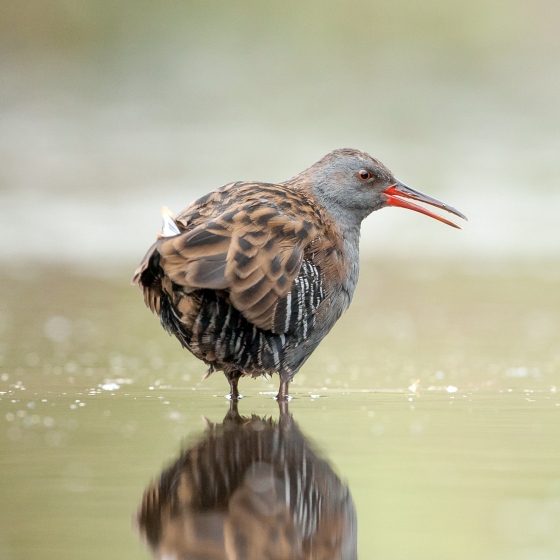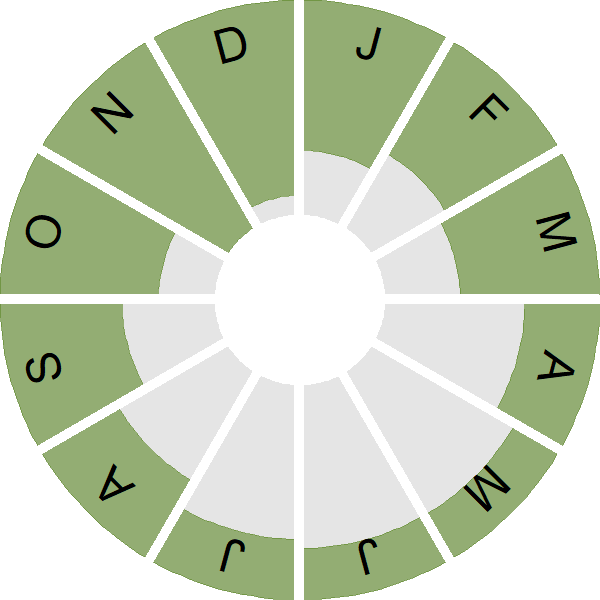Water Rail

Introduction
A member of the crake family, the Water Rail, with its long red bill and black-and-white striped sides, favour the lush dense vegetation associated with waterbodies and wet ground.
This is a species that is more often heard than seen, and this is one reason why this is such a difficult bird to census. It is thought that around 4,000 pairs breed in the UK.
During the winter the most common call is a 'pig-like' squeal and Water Rail squealing are often referred to as 'sharming'. The species can be adversely affected during periods of prolonged freezing conditions, and individuals will move elsewhere in search of warmer conditions. Birds from Europe bolster numbers during the winter and the BirdTrack reporting rate graph shows records peaking at this time.

Key Stats
Identification
Songs and Calls
Song:
Call:
Flight call:
Other:
Status and Trends
Conservation Status
Population Change
The Water Rail is a secretive species and hence difficult to monitor robustly. Atlas data show a small (6%) increase in the number of occupied 10-km squares in Britain since 1968–72, but it is uncertain whether this reflects a real change or differences in observer coverage (Balmer et al. 2013). The UK population has recently been estimated at 3,900+ pairs taking into account county estimates and dedicated site surveys (Francis et al. 2020). The species had been added to the list of species considered by the Rare Breeding Birds Panel in 2006 but it was dropped in 2018 as a result of this revised UK population estimate. The population is most likely to be stable or increasing, but this is uncertain due to the unreliability of monitoring.
Distribution
Breeding Water Rails are patchily distributed throughout the lowlands of Britain and Ireland. In winter they are twice as widespread in Britain perhaps because resident breeders are supplemented by migrants from continental Europe.
Occupied 10-km squares in UK
or view it on Bird Atlas Mapstore.
or view it on Bird Atlas Mapstore.
European Distribution Map
Distribution Change
Changes in range are difficult to interpret for this difficult to detect species.
Change in occupied 10-km squares in the UK
or view it on Bird Atlas Mapstore.
or view it on Bird Atlas Mapstore.
Seasonality
Water Rails are present throughout the year, sometimes heard in the breeding season but more often seen in winter months.
Weekly pattern of occurrence
The graph shows when the species is present in the UK, with taller bars indicating a higher likelihood of encountering the species in appropriate regions and habitats.

Movement
Britain & Ireland movement
Foreign locations of birds ringed or recovered in Britain & Ireland
Dots show the foreign destinations of birds ringed in Britain & Ireland, and the origins of birds ringed overseas that were subsequently recaptured, resighted or found dead in Britain & Ireland. Dot colours indicate the time of year that the species was present at the location.
- Winter (Nov-Feb)
- Spring (Mar-Apr)
- Summer (May-Jul)
- Autumn (Aug-Oct)

European movements
EuroBirdPortal uses birdwatcher's records, such as those logged in BirdTrack to map the flows of birds as they arrive and depart Europe. See maps for this species here.
The Eurasian-African Migration Atlas shows movements of individual birds ringed or recovered in Europe. See maps for this species here.
Biology
Productivity and Nesting
Nesting timing
Egg measurements
Clutch Size
Survival and Longevity
Survival is shown as the proportion of birds surviving from one year to the next and is derived from bird ringing data. It can also be used to estimate how long birds typically live.
View number ringed each year in the Online Ringing Report.
lifespan
Biometrics
Wing length and body weights are from live birds (source).
Wing length
Body weight
Ring Size
Classification, names and codes
Classification and Codes
- Order: Gruiformes
- Family: Rallidae
- Scientific name: Rallus aquaticus
- Authority: Linnaeus, 1758
- BTO 2-letter code: WA
- BTO 5-letter code: WATRA
- Euring code number: 4070
Alternate species names
- Catalan: rascló occidental
- Czech: chrástal vodní
- Danish: Vandrikse
- Dutch: Waterral
- Estonian: rooruik
- Finnish: luhtakana
- French: Râle d’eau
- Gaelic: Gearradh-dubh-nan-allt
- German: Wasserralle
- Hungarian: guvat
- Icelandic: Keldusvín
- Irish: Ralóg Uisce
- Italian: Porciglione
- Latvian: dumbracalis
- Lithuanian: ilgasnape vištele
- Norwegian: Vannrikse
- Polish: wodnik (zwyczajny)
- Portuguese: frango-d'água
- Slovak: chriaštel vodný
- Slovenian: mokož
- Spanish: Rascón europeo
- Swedish: vattenrall
- Welsh: Rhegen Dwr
- English folkname(s): Velvet Runner, Skittycock, Sharmer
Research
Causes of Change and Solutions
Causes of change
Given the difficulty in monitoring this species it is unclear whether there have been any changes in population, although it is likely that the population is stable or increasing (Francis et al. 2020). The small increase in range since 1968–72 could perhaps have been prompted by relatively mild winters during the 1990s and 2000s but it is unclear whether the increase is genuine and it may result simply from improved observer coverage (Balmer et al. 2013). Habitat restoration and creation for other reedbed specialists such as the Bittern may also have benefited the Water Rail.

